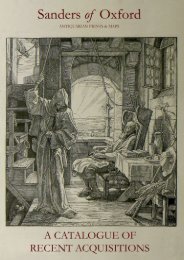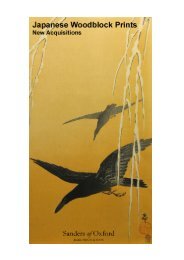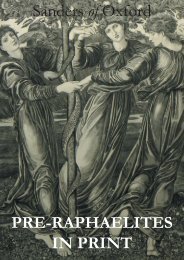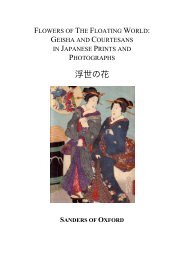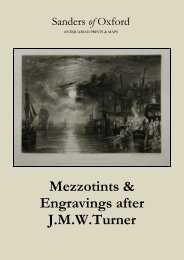«Heading» - International League of Antiquarian Booksellers
«Heading» - International League of Antiquarian Booksellers
«Heading» - International League of Antiquarian Booksellers
Create successful ePaper yourself
Turn your PDF publications into a flip-book with our unique Google optimized e-Paper software.
8. The Early Ploughman, or, The Morning Spread upon the Mountains<br />
Etching<br />
Samuel Palmer<br />
c.1860 printed in 1926<br />
Image 132 x 198 mm, Plate 175 x 250 mm, Sheet 267 x 374 mm<br />
Initialled below image in pencil by Frank Short, Martin Hardie and Frederick Landseer Griggs.<br />
A stunning impression, one <strong>of</strong> the final seventy five impressions issued by the afforementioned three artists before the<br />
plate was destroyed, as indicated by the triangle inscribed before the signatures.<br />
Samuel Palmer (1805 – 1881) was a visonary artist and contemporary <strong>of</strong> William Blake. A key figure in British<br />
Romanticism he was also a prolific writer as well as a watercolourist, etcher and printmaker.<br />
Palmer is best known for his early works executed at Shoreham where he lived between 1826 to 1835. Introduced to<br />
William Blake by John Linnel (whose daughter he would later marry) Palmer and artists George Richmond and Edward<br />
Calvert formed a group named The Ancients who were charicterized by their admiration for the work <strong>of</strong> William Blake<br />
and their attraction to archaism in art.<br />
Like many great artists, it was not until after death that the works <strong>of</strong> Samuel Palmer were rediscovered and finally<br />
afforded the attention they deserved. Although his watercolours were popular in England at the time, Palmer struggled<br />
financially throughout his life time and had to divert much <strong>of</strong> his attentions to teaching to support himself and his wife,<br />
Hannah Linnel.<br />
After his death in 1881, Samuel Palmer was largely forgotten, his surviving son, Alfred Herbert Palmer, even went as far<br />
as to burn a large portion <strong>of</strong> his fathers work in 1901, stating that: "Knowing that no one would be able to make head or<br />
tail <strong>of</strong> what I burnt; I wished to save it from a more humiliating fate".<br />
In 1926 Martin Hardie curated a show at the Victoria and Albert Museum entitled Drawings, Etchings and Woodcuts<br />
made by Samuel Palmer and other Disciples <strong>of</strong> William Blake. This kick-started the revival <strong>of</strong> interest in Palmers work<br />
which subsequent retrospective exhibtions and publications have continuously reinforced thoughout out the rest <strong>of</strong> the<br />
20th century. The Shoreham work in particular has had a noteable influence on several important 20th century artists<br />
such as Frederick Landseer Griggs, Robin Tanner, Graham Sutherland, Paul Drury and Eric Ravilious.<br />
Condition: an excellent impression in very fine condition, full margins.<br />
[27752]<br />
£2,100




